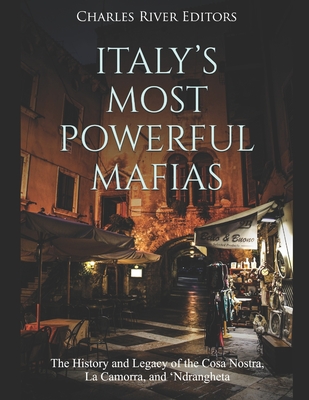Italy's Most Powerful Mafias: The History and Legacy of the Cosa Nostra, La Camorra, and 'Ndrangheta

Italy's Most Powerful Mafias: The History and Legacy of the Cosa Nostra, La Camorra, and 'Ndrangheta
*Includes a bibliography for further reading
The word "mafia," Sicilian in origin, is synonymous with Italy, but Italy is home to several different mafias, with three being particularly notorious. While the Cosa Nostra of western Sicily is the most infamous, other powerful groups include the ferocious 'Ndrangheta of Calabria and the Camorra, the third-largest mafia, which is active in Naples and the Campania region. A "mafia" is loosely defined as a criminal organization that is interested in social, economic and political power, combining elements of a traditional secret society with those of a business, but further levels of nuance are necessary in order to understand these groups. In a general sense, this is because each mafia creates a myth about the development of the organization, which becomes like an unquestionable truth. In essence, part of what makes its members so completely loyal to it is also what makes outsiders so utterly afraid of it.
Over the course of the 19th century, the people of Sicily found themselves at the center of a struggle for freedom, one that ended up being long and often very bloody. It was during these crucial years of struggle that the Sicilian mafia, La cosa nostra ("Our thing"), started to take shape. The original word "mafia" was a part of Palermitan slang, and although the origins of the word are not completely certain, some linguistic historians believe it originally meant "flashy." One historian of the mafia, Salvatore Lupo, helpfully suggests that it was used in its earliest iterations to vaguely refer to a "pathological relationship among politics, society and criminality."
In the particular case of the Camorra, the difficulty of understanding an underground criminal association is made all the more intense because it is so heterogeneous in terms of its development, its different functions, and the diversity of economic sectors in which it operates. To reflect that diversity, some scholars like to refer to it as Camorre, the plural version of Camorra. This decision is more than just a question of semantics, because using the plural form helps emphasize the internal differences and conflicts within the Neapolitan mafia, which, in turn, helps explain the very nature of the organization itself. The Neapolitan mafia is famous for its pervasive nature, which is due to the fact that it is organized in a horizontal, decentralized way. This means there is not one single "boss" who dictates
PRP: 125.08 Lei
Acesta este Pretul Recomandat de Producator. Pretul de vanzare al produsului este afisat mai jos.
106.32Lei
106.32Lei
125.08 LeiLivrare in 2-4 saptamani
Descrierea produsului
*Includes a bibliography for further reading
The word "mafia," Sicilian in origin, is synonymous with Italy, but Italy is home to several different mafias, with three being particularly notorious. While the Cosa Nostra of western Sicily is the most infamous, other powerful groups include the ferocious 'Ndrangheta of Calabria and the Camorra, the third-largest mafia, which is active in Naples and the Campania region. A "mafia" is loosely defined as a criminal organization that is interested in social, economic and political power, combining elements of a traditional secret society with those of a business, but further levels of nuance are necessary in order to understand these groups. In a general sense, this is because each mafia creates a myth about the development of the organization, which becomes like an unquestionable truth. In essence, part of what makes its members so completely loyal to it is also what makes outsiders so utterly afraid of it.
Over the course of the 19th century, the people of Sicily found themselves at the center of a struggle for freedom, one that ended up being long and often very bloody. It was during these crucial years of struggle that the Sicilian mafia, La cosa nostra ("Our thing"), started to take shape. The original word "mafia" was a part of Palermitan slang, and although the origins of the word are not completely certain, some linguistic historians believe it originally meant "flashy." One historian of the mafia, Salvatore Lupo, helpfully suggests that it was used in its earliest iterations to vaguely refer to a "pathological relationship among politics, society and criminality."
In the particular case of the Camorra, the difficulty of understanding an underground criminal association is made all the more intense because it is so heterogeneous in terms of its development, its different functions, and the diversity of economic sectors in which it operates. To reflect that diversity, some scholars like to refer to it as Camorre, the plural version of Camorra. This decision is more than just a question of semantics, because using the plural form helps emphasize the internal differences and conflicts within the Neapolitan mafia, which, in turn, helps explain the very nature of the organization itself. The Neapolitan mafia is famous for its pervasive nature, which is due to the fact that it is organized in a horizontal, decentralized way. This means there is not one single "boss" who dictates
Detaliile produsului









